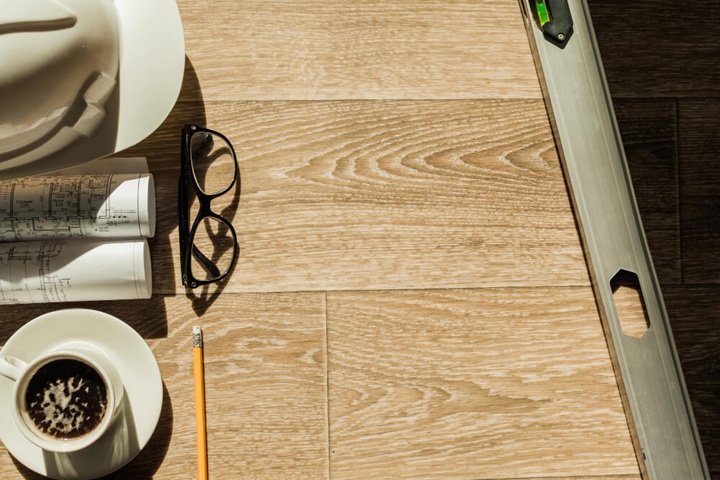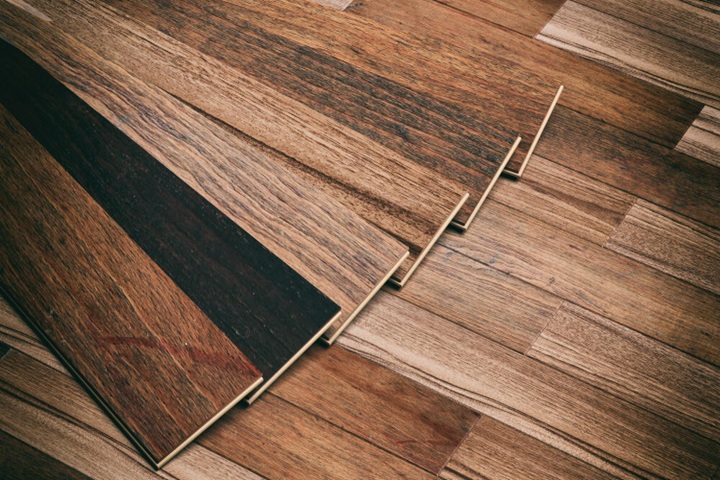Laminate underfloor heating is the perfect way to eliminate cold spots and maximise energy efficiency, with an easy to clean floor.
Key Points:
- Learn about the compatibility of laminate flooring with underfloor heating.
- Discover which installation methods are better with an overview of adhesive versus floating installations.
- Find out which floor temperatures are the most efficient with laminate flooring for underfloor heating.
Are you considering a stylish yet functional flooring solution? Laminate flooring might just be the perfect match for your underfloor heating.
Laminate flooring offers a practical, attractive solution for homes with or without underfloor heating, perfect for contemporary, period, new builds, and more. In this article, you will learn about how to install laminate flooring with underfloor heating systems, the benefits and drawbacks, installation methods, and essential considerations like temperature control and material thickness.
- Is laminate flooring suitable for Underfloor Heating?
- Benefits Of Laminate Floors With Underfloor Heating
- How to install underfloor heating over laminate
- Things to consider with underfloor heating and Laminate Flooring
Is laminate flooring suitable for Underfloor Heating?
Laminate flooring is a popular choice for those seeking to replicate the look of hardwood or stone without the high maintenance associated with natural materials. It is often available in scratch-resistant finishes and is resistant to water and spills, making it ideal for homes with children or pets.
Laminate is similar to engineered wood flooring and is constructed from multiple layers. It typically features a high-density fibreboard (HDF) core that provides stability and offers the visual appeal of wood or stone with a protected top layer.
If you are considering underfloor heating for laminate flooring, there are a few important factors to consider.
Benefits Of Laminate Floors With Underfloor Heating
Underfloor heating under laminate flooring has several key advantages:
- Durability: Laminate’s protective layer makes it more wear and tear-resistant than wood to ensure long-lasting performance.
- Temperature Stability: Laminate is ideal for underfloor heating as it resists warping and buckling under temperature changes
- Efficient Heating: Laminate’s thin profile allows for quick and even heat distribution whilst providing consistent warmth.
- Low Maintenance: Laminate flooring is one of the best underfloor for heating flooring as it is easier to clean and maintain.
- Cost-Effective: Laminate is affordable and works efficiently with underfloor heating to create energy savings over time.
Underfloor Heating Kits For Laminate Flooring
- 9m2 Electric underfloor heating 150w Sticky Mat Kit Incl. Vat: £141.43 | £117.86
- 8m2 Electric underfloor heating 150w Sticky Mat Kit Incl. Vat: £128.47 | £107.06
- 7m2 Electric underfloor heating 150w Sticky Mat Kit Incl. Vat: £113.70 | £94.75
- 6m2 Electric underfloor heating 150w Sticky Mat Kit Incl. Vat: £99.30 | £82.75
How to install underfloor heating over laminate

Installing underfloor heating under laminate flooring is a great way to add comfort and efficiency to your home. Laminate flooring is designed to be quickly fitted together, making it easy to add to underfloor heating systems.
Choose the right underfloor heating system:
Selecting the right electric or water underfloor heating system is crucial for laminate flooring. Dry installation methods are recommended, as they eliminate the need for screeding, which can delay the process. Electric underfloor heating systems are often preferred for laminate flooring due to their compatibility and ease of installation. You can consult a professional to determine the best system for your specific needs to ensure it will provide efficient heating without compromising the integrity of the laminate flooring.
Preparing the Subfloor and Underlay:
Proper subfloor preparation is vital for the success of your laminate underfloor heating installation. Ensure the subfloor is clean, dry, and level before laying the heating elements. The choice of underlay is also essential. It should be breathable and have a thickness between 3mm and 6mm. This thickness allows the heat to efficiently transfer from the underfloor heating system to the laminate flooring to provide even warmth throughout the room. Avoid using thick or dense underlays that could hinder the heating process.
Installing the Laminate Floorboards:
Laminate flooring is designed for straightforward installation and often features a click-lock system that allows the boards to snap together easily. This method is particularly well-suited for underfloor heating laminate installations, as it enables the flooring’s natural expansion and contraction without the risk of buckling. When installing the laminate boards, start from one corner of the room and work your way across to ensure a snug fit between each board.
Floating Installation vs. Adhesive Installation:
Floating and adhesive installations are the two primary methods for installing laminate flooring over underfloor heating.
Floating Installation: This method involves laying the laminate boards over the underlay and subfloor without using adhesives or nails. Floating installations are popular for their simplicity and flexibility, allowing the flooring to adjust to temperature changes. This method reduces the risk of damage and allows for quick laminate installation with underfloor heating.
Adhesive Installation: Adhesive may be necessary to secure the laminate flooring in areas with extra stability. The underfloor heating adhesives ensure a strong bond between the laminate boards and the subfloor. To avoid any potential damage, it’s crucial to use adhesives specifically designed for underfloor heating laminate floors. Always consult with your flooring supplier to choose the suitable adhesive for your laminate flooring.
Managing Expansion Gaps:
Leaving an appropriate expansion gap around the room’s perimeter is critical when installing laminate flooring with underfloor heating. A gap of around 15mm is recommended to accommodate any expansion due to changes in temperature or humidity. This gap is usually hidden beneath the skirting boards to maintain the room’s aesthetic appeal while preventing the laminate from buckling or warping.
First-Time Heating:
When you first activate your underfloor heating system, gradually increase the temperature. If you are unsure how to turn your underfloor heating on and off, Start by setting the thermostat to a low temperature and then increase it by approximately 5 degrees daily until you reach the desired temperature. This gradual heating process helps prevent thermal shock that can cause the laminate flooring to warp or sustain damage.
Get A Bespoke Quote Today
You can now take advantage of our online quote system.
Just fill up a short form with your name, number, email and project details and we will get in touch with a bespoke quote for you.
Things to consider with underfloor heating and Laminate Flooring

Underfloor heating for laminate flooring has several key factors to ensure optimal performance, longevity and comfort. Here are the most critical considerations:
1. Floor Temperature Management
The maximum temperature that laminate flooring should be exposed to is 27°C. Exceeding this temperature can damage the flooring by causing warping or discolouration. To help prevent this, it’s recommended that you install a floor temperature sensor with your underfloor heating system.
2. Laminate Flooring Thickness
The thickness of the laminate plays a crucial role in heat transfer efficiency. Thicker laminate boards are typically above 18mm and can slow heat transfer, making your underfloor heating system less efficient. Choosing laminate flooring that is no thicker than 18mm allows the heat to pass through effectively.
3. Underlay Considerations
Underlay is an essential layer in your flooring system, especially when using underfloor heating under laminate flooring. The underlay must be compatible with underfloor heating and should generally be between 3mm and 6mm thick. Thicker underlay can insulate the heat and reduce the system’s efficiency. The underlay should also be breathable to allow moisture to escape.
4. Heating System Compatibility
Different underfloor heating systems require different installation methods, which aren’t all suitable for laminate flooring. Systems with multi-layered insulation solutions ensure that your laminate flooring stays at an optimal temperature without risking damage.
5. Thermal Conductivity of Laminate Flooring
Laminate flooring has a multi-layered structure that often includes a dense fibreboard core. This design provides the stability and durability that make laminate a good conductor and distributor of heat.
6. Durability and Maintenance
Laminate flooring is known for its durability, which makes it an excellent choice for homes with underfloor heating. Unlike natural wood, laminate is less prone to warping or shrinking due to temperature fluctuations. This means the flooring maintains its appearance and structural integrity over time, even when exposed to the consistent heat of underfloor heating.
You can ensure that your underfloor heating under laminate flooring not only operates efficiently but also extends the life and beauty of your flooring. Proper installation and careful management of temperature and materials will help you achieve the perfect home environment.
New to Underfloor Heating?
Use below links to browse our key pages
- What is underfloor Heating?
- Installation Guides
- Try Out System Selector
- Visit Our Help Centre
- What Our Customers Say
FAQs
Can laminate flooring be used with underfloor heating?
Both electric and water underfloor heating systems work well with laminate flooring. Typically, electric systems are favored for renovations and smaller to medium-sized rooms, while water-based systems are more commonly used in new builds and larger spaces.
Do you need underlay with laminate underfloor heating?
When using underfloor heating, it’s recommended to use underlay with your laminate flooring. Underlay maintains heat resistance within acceptable limits, helps prevent rising damp and condensation, and reduces the risk of open joints during the heating season.
Is LVT better than laminate underfloor heating?
The thicker the laminate, the better the insulation of the floor. LVT floors are typically warmer and quieter underfoot but may feel cold if installed over concrete or existing ceramic tile. Adding an underlay can improve warmth and comfort. If you’re seeking good sound absorption, look for options designed to minimize noise.
Do you lose heat through laminate flooring?
Laminate is known for its temperature-absorbent properties, which can make it feel cool underfoot, especially during winter when cold air may seep through from the subfloor. However, this doesn’t have to be a major issue.
